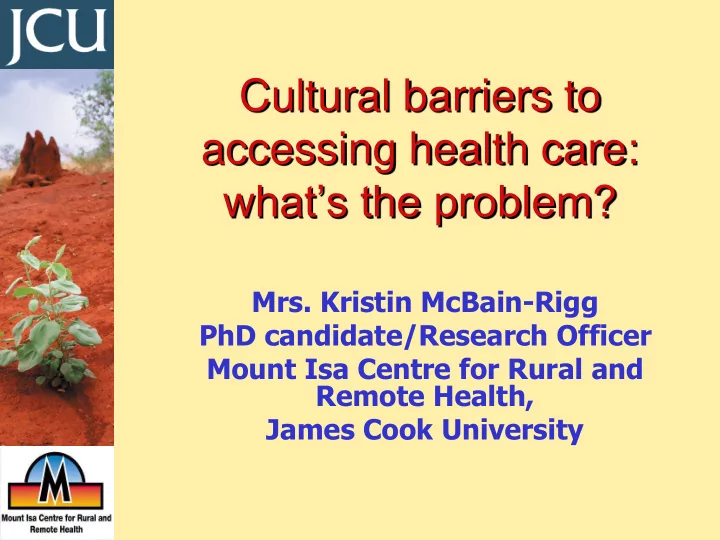

Cultural barriers to accessing health care: what’s the problem? Mrs. Kristin McBain-Rigg PhD candidate/Research Officer Mount Isa Centre for Rural and Remote Health, James Cook University
Background Access barriers to mainstream services for minority populations: Top three issues • Transportation and distance • Cost and lack of private health cover • Language and cultural issues leading to possible misdiagnosis and inappropriate care
Ambitious aims • To assess access barriers experienced by Aboriginal and Torres Strait Islander peoples in Mount Isa Queensland. • Particular focus on what constitutes „cultural barriers‟
• UDRH‟s in Australia. Sourced from ARHEN
Methods • Lived and worked in Mount Isa since 2005 • Ethnographic fieldwork in Mount Isa 2007 to 2009: – Participant observation – Formal and informal interviews with key informants • Dadirri method of interviewing – Fieldwork diaries documenting local events • Thematic analysis of interviews conducted to show emerging themes and points of contention • Not necessarily transferable or generalisable; though most of the findings confirm established knowledge
Critical Medical Anthropology • Based on a Critical Medical Anthropology framework: – Emerged as distinct theoretical perspective in 1980s – Focus: the links between individual micro-level experience and macro-level political, historical, economic influences – Designed to understand the health of the population by examination on three levels as defined by the „Mindful Bodies‟ approach of Scheper -Hughes and Lock
Mindful bodies • Advocates the deconstruction of received notions of the body by examining: – A phenomenologically experienced individual body-self – Social body (body as natural symbol) – Body politic (body as artefact of social and political control) Study of emotions new way forward
5A’s of Access • Penchansky and Thomas (1981) developed taxonomy: – Access has 5 aspects: • Accessibility • Availability • Affordability • Accommodation • Acceptability
Culture • Use and centrality still debated in anthropological circles • Has changed from humanist, “culture as evolutionary stages of civilisations‟ to and anthropological „recognition of the multiplicity of culture, each judged on own merits, examining differences on their own merits.
Culture • A pervasive and integrated system of ideas and beliefs held in common by a group of people, provides a framework of meaning • System incorporates implicit and explicit rules for behaviour • Knowledge transmitted through language and practice • Dynamic, although it has a continuous dimension • Culture is LEARNED, not biological
Table 1. Some cultural barriers as represented by Aboriginal and Torres Strait Islander participants. Social Cultural Structural Family situation and access to Taken-for-granted lifestyle assumptions Lack of flexibility in health systems health care Taking away the sociality of Roles of kin and others in care Lack of communication and understanding patients – isolating the between providers and patients individual from kin and social networks Difference blindness Shame – being caught not going and not Complex bureaucracies in health and social wanting to go to services support systems make it difficult to navigate between Shame - involving gender differences or family roles and obligations/taboos Gender differentials among patients and So many providers providing so many providers interventions (often overlapping and not explained) Respect and reciprocity issues Expectation that Aboriginal communities can and will keep pace with changes in medical systems health care models and styles of engagement Fear of hospitals or other health care institutions
Table 2. Some cultural barriers as represented by health practitioners Social Cultural Structural/systems Limited ability to Inclusion of symbols and signs (like Non-compliance with appointment pay for services Aboriginal artwork) schedules restricting choice of provider A perception (or evidence) of poor A lack of understanding of separate provider attitudes or understandings of systems Aboriginal cultures A lack of health literacy and health systems literacy Dis/comfort with the physical environment of a service Need for many services in one, central location
Differences in perspective • Aboriginal patients – Issues of conduct, respect, reciprocity • Health professionals – Comfort, appropriateness, physical environment
Mystifying arguments • Having culture: Aboriginal people taking back their culture and asserting it to demonstrate difference and the need for flexible systems • Does this hide or obscure other cultures in Mount Isa? • Biomedical knowledge mystified: some Aboriginal people feel they „just don‟t get‟ mainstream health systems
On the road to Cloncurry .
Conclusions • Anthropology helps examine disadvantage and accessibility issues in ways not fully explored in the medical literature. • Term „cultural barriers‟ requires further refinement: perhaps better to discuss cultural difference, not cultural barriers • Need for increased understanding, not just awareness on both sides of cultural debate
Ethos: Dr. LG Peachey “If non -Indigenous Australians will walk with us to find solutions for the health problems of Indigenous people, their gift in return will be a better understanding of non- Indigenous people who are marginalised and disenfranchised…” Dr. Louis G Peachey – Girrimay man of Djiribal language group; Foundation President of Australian Indigenous Doctors Association (AIDA)
Recommend
More recommend